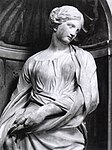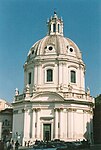Trajan's Column

Trajan's Column (Italian: Colonna Traiana, Latin: Columna Traiani) is a Roman triumphal column in Rome, Italy, that commemorates Roman emperor Trajan's victory in the Dacian Wars. It was probably constructed under the supervision of the architect Apollodorus of Damascus at the order of the Roman Senate. It is located in Trajan's Forum, north of the Roman Forum. Completed in AD 113, the freestanding column is most famous for its spiral bas relief, which depicts the wars between the Romans and Dacians (101–102 and 105–106). Its design has inspired numerous victory columns, both ancient and modern. The structure is about 30 metres (98 feet) in height, 35 metres (115 feet) including its large pedestal. The shaft is made from a series of 20 colossal Carrara marble drums, each weighing about 32 tons, with a diameter of 3.7 metres (12.1 feet). The 190-metre (620-foot) frieze winds around the shaft 23 times. Inside the shaft, a spiral staircase of 185 steps provides access to a viewing deck at the top. The capital block of Trajan's Column weighs 53.3 tons, and had to be lifted to a height of about 34 metres (112 feet).Ancient coins indicate preliminary plans to top the column with a statue of a bird, probably an eagle. After construction, a statue of Trajan was put in place; this disappeared in the Middle Ages. On December 4, 1587, the top was crowned with a bronze figure of Saint Peter the Apostle by Pope Sixtus V, which remains to this day.Trajan's Column was originally flanked by two sections of the Ulpian Library, a Greek chamber and a Latin chamber, which faced each other and had walls lined with niches and wooden bookcases for scrolls. The Latin chamber likely contained Trajan's commentary on the Roman-Dacian Wars, the Dacica, which most scholars agree was intended to be echoed in the spiralling, sculpted narrative design of Trajan's Column.
Excerpt from the Wikipedia article Trajan's Column (License: CC BY-SA 3.0, Authors, Images).Trajan's Column
Foro Traiano, Rome Municipio Roma I
Geographical coordinates (GPS) Address Website Nearby Places Show on map
Geographical coordinates (GPS)
| Latitude | Longitude |
|---|---|
| N 41.895833333333 ° | E 12.484166666667 ° |
Address
Foro di Traiano
Foro Traiano
00184 Rome, Municipio Roma I
Lazio, Italy
Open on Google Maps









